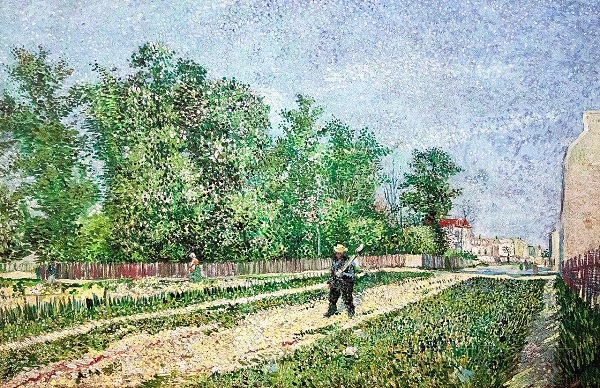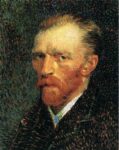
Vincent Van Gogh
Dutch, 1853-1890 (active France)
Road to the Outskirts of Paris, 1887
oil on canvas

Van Gogh - Self-Portrait, Spring 1887
"If, therefore, you’ve already considered that Signac and the others who are doing pointillism often make very beautiful things with it — Instead of running those things down, one should respect them and speak of them sympathetically..."
- Letter to Emile Bernard. December 1887
COMMENTS
At the end of February 1886, after studying for three months at the academy in Antwerp, Van Gogh arrived in Paris, the epicenter of modern French art, where he started to learn about the latest developments in the art world. It must have made him painfully aware that his own ideas, which were mainly based on the work of Eugene Delacroix and the painters of the Barbizon and Hague schools, were outdated. He had got a vague idea of what Impressionism was from the sparse information passed on by his brother Theo, who had been living in Paris since 1879, but in Antwerp he had obviously heard nothing about the rise of Neo-Impressionism, which was gripping the avant-garde world in Paris by the time he arrived there.
The Symbolist writer and art critic, Félix Fénéon, introduced the term Neo-Impressionism in September 1886 to describe the sensational works being produced by artists such as Georges Seurat, Paul Signac and Camille and Lucien Pissarro, which had been intriguing him since the eighth Impressionist exhibition in May that year. “Sunday afternoon on the island of La Grande Jatte”, which had been entered in the show by Seurat, the movement’s leader, dominated the exhibition by its size alone, and Fénéon raved about it: ‘His immense canvas, La Grande Jatte, whatever part of it you examine, unrolls, a monotonous and patient tapestry: here in truth the accidents of the brush are futile. Trickery is impossible; there is no place for bravura — let the hand be numb, but let the eye be agile, perspicacious, cunning.” This uniform, canvas-filling tapestry was created using a time-consuming and anti-academic technique of short brushstrokes, also called "pointes". The shape, size and density of these dots depended on the size of the work and their place in the composition. There was also a set of strict rules governing the Neo-Impressionist use of color. Only pure colors were allowed, and they were applied in accordance with the rules of the complementary color theory, which distinguishes the following contrasting pairs of primary colors and their counterparts on the color wheel: red and green, blue and orange, yellow and violet. An equal mixture of these color pairs looks grey, while an unequal mixture allows one of the colors to predominate, which is also called "ton rompu" (broken tone). When they are placed beside each other on the canvas, though, these complementary colors reinforce each other, and the results can be powerful and expressive. In theory, the best way to achieve this is by rejecting any mixing of colors on the palette, apart from adjacent colors on the color wheel and white. This constant focus on contrasting colors helped to create a harmony that permeated to the smallest details of a composition. The Neo-Impressionists assumed above all that the optical blending of the individual brushstrokes in the eye of the observer, known as “mélange optique” or optical mixing, would spread a pulsing radiance over the canvas.
During the two years that Van Gogh spent in Paris, this manner of working with the "pointe" and the derived principle of the separate application of colors with systematic small strokes, which is also called Divisionism, grew to become the new path followed by young artists. Van Gogh’s acquaintance with Neo-Impressionism contributed to the drastic change that his own art underwent in this period. . . .
The First Steps towards Neo-Impressionism: Peinture a L’essence
In the winter of 1886-87 Van Gogh underwent an important personal development when his friendship with the former Cormon students Toulouse-Lautrec and Anquetin, through whom he had since been introduced to Emile Bernard, became deeper, and he began to play a more active part in the world of the avant-garde. This receptiveness to new artistic developments was also reflected in his work. It signaled the start of his technical experiments in Paris with new colors and materials." That winter and the following spring he and Lautrec simultaneously experimented with heavily thinned paint, with the result that Van Gogh temporarily exchanged his distinctive loaded brush for a delicate, draftsman-like manner.” He now learned to incorporate the opaque white ground layer as an element that gave his compositions light and unity, a discovery he made use of in his later, Neo-Impressionist experiments. . . .
The Quest for Sunlight
Van Gogh’s exercises with the “peinture a L’essence” technique lasted until mid-April 1887. When the weather improved his thoughts turned to painting out of doors, first in the familiar surroundings of Montmartre and from the middle of May in Asnieres, a village on the Seine north of Paris that was within walking distance of rue Lepic. And after his brief flirtation with thinned paint, he also returned to his highly textured brushstroke. His Works also became lighter at the same time. The change was so remarkable that Theo referred to it as follows in a letter of 15 May 1887 to their sister Willemien: “Vincent is still working hard and is making progress. His paintings are becoming lighter, & his great quest is to get sunlight into them?" Paradoxically, Van Gogh achieved these effects from mid-May to the end of June not primarily by going out and painting in the open air but in four carefully prepared Neo-Impressionist works that he executed in his studio: “Square Saint-Pierre”, “Road to the Outskirts of Paris”, “Garden with courting couples: Square Saint-Pierre”, and to a lesser extent “Interior of a restaurant”. The ambitious size of these works may betray the influence of Seurat and Signac but at the same time it is also testimony to the self-confidence with which Van Gogh embarked on this new adventure. He could no longer rely on the support of Anquetin and Bernard for these experiments with Neo-Impressionism, for after a visit to Signac’s studio in March 1887, where they saw his newly completed “Breakfast”, among other works, they realized that the Neo-Impressionist technique was too much of a straitjacket for them.
According to Hendriks and Van Tilborgh, Van Gogh was inspired to make these reasonably systematic Pointillist canvases after seeing works by Seurat and Signac again at the Indépendants and examining Pissarro’s fully-fledged Neo-Impressionist works in the gallery of the art dealer Georges Petit. This phase probably received an extra stimulus from the short-lived personal contact between Van Gogh and Signac in this period. His study of the pictures at the above exhibitions led Van Gogh to the conclusion that it was not the glimmer of the white ground layer showing through the overlying paint that gave the works of Seurat and Signac their bright, light radiance, but the addition of white to a stippled tapestry covering the entire canvas. “Road to the Outskirts of Paris” is Van Gogh’s most consistent exploration of his systematic Pointillist stippling. The complementary color contrasts that were so important to the Neo-Impressionists play only a secondary role. It was in a few details alone that Van Gogh incorporated the contrasting pair of red and green, such as the red roof beside the green tree and the woman’s red jacket standing out against the green fence. It was precisely at these points that he used impasted brushstrokes — confirmation that he considered experimenting with a new way of applying the paint more important than creating a genuine Neo-Impressionist painting.
- Suzanne Veldink, Van Gogh and Neo-Impressionism, in Van Gogh’s Studio Practice, Marije Vellekoop, Ed., Amsterdam: Van Gogh Museum, 2013, 350-363
SBMA CURATORIAL LABELS
In the spring and summer of 1887, Van Gogh developed a friendship with Paul Signac, who, along with Georges Seurat, was a leading practitioner of the technique known as pointillism, in which small dots of complementary colors are juxtaposed but left unblended to create a heightened intensity of hue. This verdant landscape is an unusual example of Van Gogh’s disciplined experimentation with pointillism—a time-consuming technique that he would later adapt into more rapidly applied dashes and dots, somewhat akin to Camille Pissarro’s adaptation of pointillist brushwork in the same years. By the time that Van Gogh arrived in Arles in February 1888, he had abandoned the pointillist dot for a rhythmic and textural mark-making that was completely his own.
- Through Vincent's Eyes, 2022
